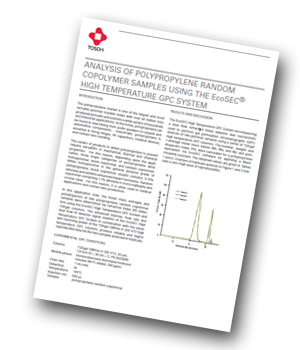Tosoh Bioscience has produced an application note determining the molar mass averages and polydispersity of two polypropylene random copolymer samples via refractive index (RI) detection using the EcoSEC High Temperature GPC System and TSKgel columns.
 Introduction
Introduction
The polypropylene market is one of the largest and most versatile polymer markets today with over 50 million tons produced annually and sold into a wide variety of household and industrial applications. The variety of products in which polypropylene is present require versatility in mechanical, thermal and chemical properties. For this reason, depending upon the application, three major categories of polypropylene exist; homopolymer, block copolymer and random copolymer. While homopolymer is the general purpose grade of polypropylene, block copolymer usually contains 5-15% ethylene and exhibits enhanced impact resistance. Random copolymer containing 1-7% ethylene is more malleable and crystal clear. For this reason, it is often used in medical applications and contact lens production.
 Experimental Conditions
Experimental Conditions
The application uses the EcoSEC high temperature GPC system and TSKgel columns. GPC conditions are detailed within the application note.
Results and Discussion
The number-, weight- and z-average molar mass values (Mn, Mw and Mz) and polydispersity index, PDI, were calculated for a polypropylene equivalent via EcoSEC software by applying a Mark-Houwink constant.
Conclusion
An EcoSEC High Temperature GPC system was used to analyse two polypropylene random copolymers. The molar mass averages, Mn, Mw and Mz, were determined via polystyrene calibration curves. The reproducibility and reliability of the dual flow refractive index detector in the EcoSEC high temperature GPC system were shown through both the very low variation in sample retention and superb baseline stability observed when overlaying three consecutive RI injections of each sample. The molar mass values were calculated by EcoSEC software for PP equivalents based on Mark-Houwink constants. The enhanced thermal, flow-rate and dual flow RI detector signal stability of the EcoSEC high temperature GPC system in combination with the excellent resolving power of the TSKgel GMHHR-H (20) HT2 high temperature GPC columns produce reliable and highly reproducible data for the two samples analysed in triplicate.




